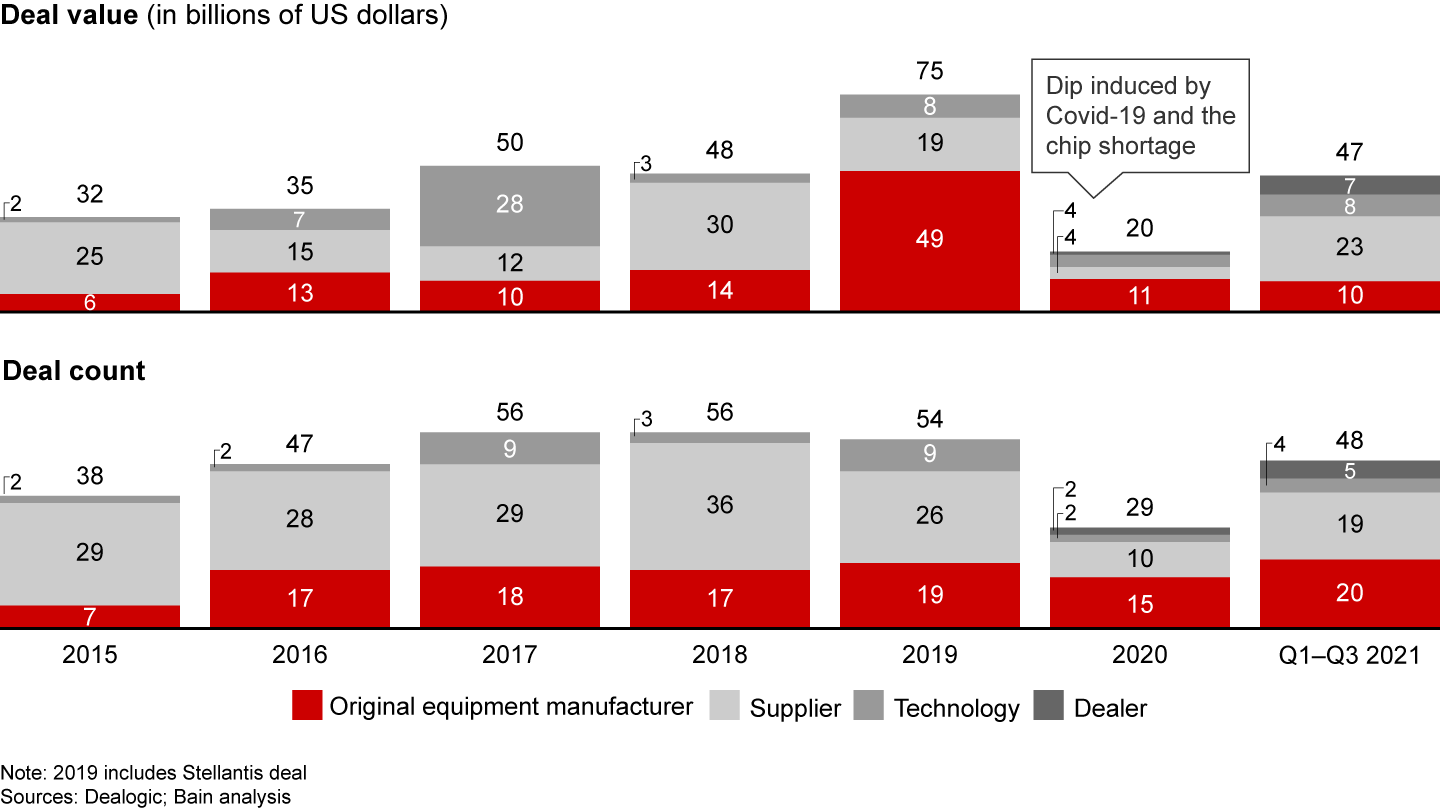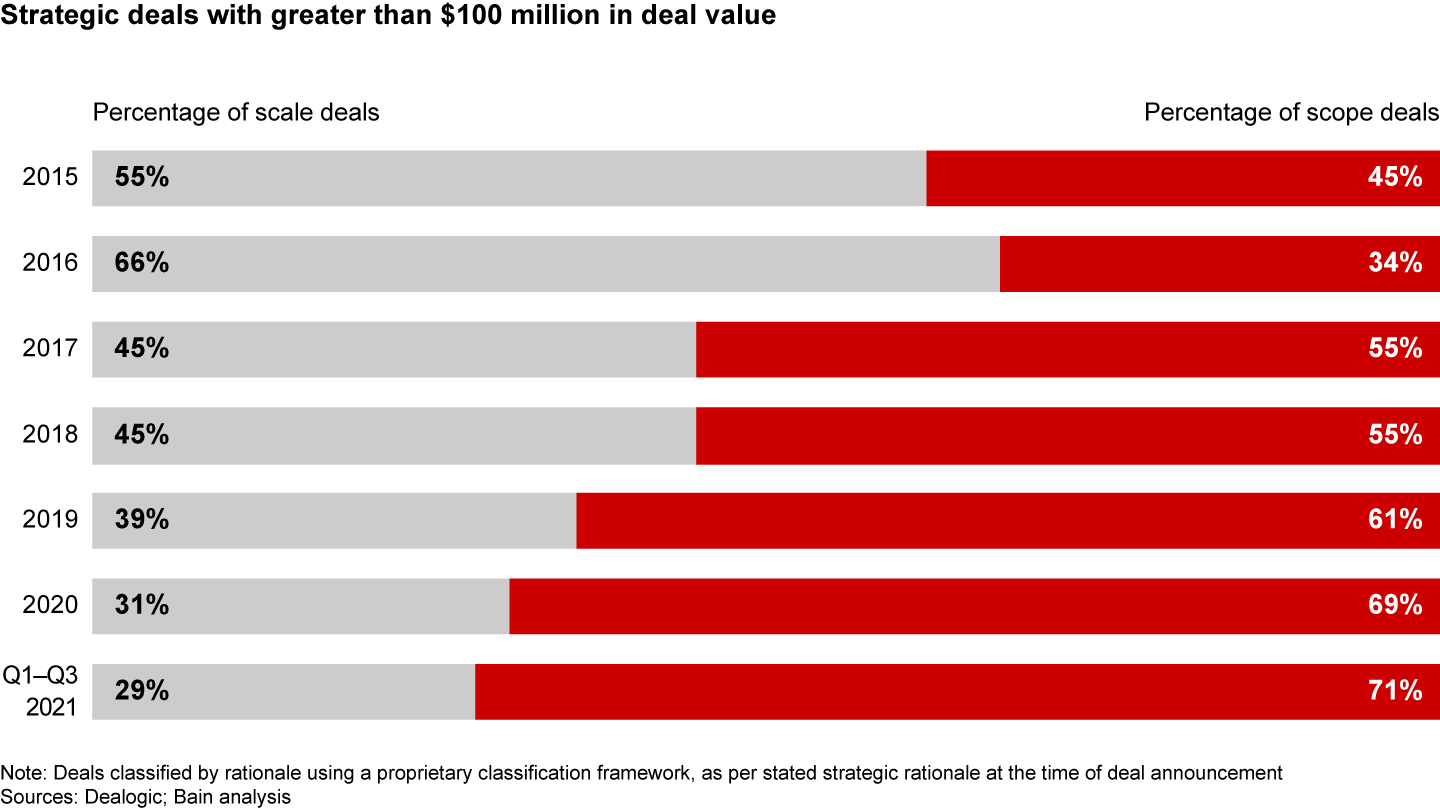M&A Report

At a Glance
- After a pandemic-induced dip in 2020 and the chip crisis in 2021, strategic M&A deal volume in the automotive and mobility industry is expected to return to a growth trajectory.
- The share of growth-oriented scope deals continues to rise. Manufacturers, in particular, are expanding their existing businesses and entering new business areas.
- Disruptive changes such as electrification, digitization, and automation are requiring manufacturers to intensify M&A to acquire newly critical capabilities on a faster timescale than feasible via organic growth.
- M&A becomes a strategic core competence. The industry can exploit the full potential with five levers.
This article is part of Bain's 2022 M&A Report.
For years, the automotive and mobility industry undervalued M&A capabilities. As recently as 2016, most activity involved traditional scale deals aimed at enabling manufacturers and suppliers to get bigger and to generate the cost synergies that come with economies of scale. The skills required were fairly straightforward to develop and rely on, deal after deal.
Now the industry finds itself deep in the biggest period of disruption in its history. In addition to consolidating for leadership, companies increasingly need to expand into new businesses and acquire new technology and innovation capabilities, especially in what we refer to as the “5 RACES”:
- Real customer focus;
- Autonomous driving;
- Connectivity and digitization of vehicles;
- Electrification of powertrains; and
- Shared mobility.
Despite a global semiconductor chip shortage and other lingering effects of the Covid-19 pandemic, as of October 2021, there were 48 deals valued greater than $100 million totaling $47 billion compared with 29 deals and $20 billion in 2020 (see Figure 1). It was a year in which private equity showed more interest, pumping up the competition; also, the number of special purchase acquisition companies increased.


Even with record volumes, automotive and mobility companies have been comparatively slow to pursue inorganic growth. As the pace of change intensifies, inorganic acquisition enables companies to quickly develop required new capabilities. Hence, they need to make M&A strategy a key part of their business strategy and aggressively sharpen their M&A muscles. That requires perfecting new approaches in screening, diligence, and integration for different kinds of deals.
There still is opportunity to consolidate for scale leadership. In fact, among the major deals of 2021 was Goodyear’s acquisition of Cooper Tire & Rubber to strengthen Goodyear’s global positioning, one of 14 scale deals totaling $13 billion last year. That consolidation takes place beyond manufacturing and suppliers. In October, Asbury Automotive Group bought Larry H. Miller Dealerships, the eighth-largest dealership group in the US, for $3.2 billion, stretching Asbury’s reach from coast to coast.
There still is opportunity to consolidate for scale leadership.
The number of scale deals is overshadowed, however, by scope deals aimed at entering a new market or acquiring a new capability. Scope deals now represent about 70% of automotive and mobility transactions with deal values greater than $100 million (see Figure 2). For example, French car parts supplier Faurecia’s acquisition of German auto lighting company Hella in 2021 helps Faurecia further expand its activities as a systems provider, increasing exposure to fast-growing segments in light of industry trends.


Suppliers such as Faurecia face growing competition from the technology companies that they seek to acquire. Qualcomm is a company better known for semiconductors, software, and services related to wireless technology. This year, however, it teamed with investment group SSW Partners to buy Swedish automotive tech company Veoneer to expand its offering for advanced driver-assistance systems.
Not all capability expansions can be managed via acquisitions, so building smart partnerships and joint ventures will be an important tool as well. As manufacturers and suppliers seek proximity to specialists in fields such as autonomous driving, these partnerships will play an important role across industries and geographies. That’s why established automobile manufacturers are now cooperating with Silicon Valley giants while European top dogs team with Chinese climbers and billion-dollar companies. For example, Stellantis and Samsung SDI entered into a memorandum of understanding to form a joint venture to produce battery cells and modules for North America (see “Delivering Results in Joint Ventures and Alliances Requires a New Playbook”).
As manufacturers and suppliers seek proximity to specialists in fields such as autonomous driving, these partnerships will play an important role across industries and geographies.
Unleash the full potential of M&A transactions
Companies in the automotive and mobility industry can only take advantage of the opportunities on the market if they have the right structures and processes in place. The best companies rely on five important levers.
- Strategic embedding of M&A: The industry has traditionally relied on organic growth and its own innovations. Pioneers follow the example of players in the healthcare and high-tech industries, making takeovers and collaborations an integral part of corporate strategy and anchoring them within their organizations.
- Fast M&A processes: Companies that only buy on a situational basis usually only put together teams on a situational basis. The resulting lag times cause them to lose out to faster competitors in the automotive and mobility industry or frustrate potential targets in high tech, as the younger companies typically have little tolerance for lengthy coordination processes.
Companies that only buy on a situational basis usually only put together teams on a situational basis. The resulting lag times cause them to lose out.
- Extended deal focus: Electrification, digitization, and automation of vehicles are changing the business of manufacturers, suppliers, and service providers. As a result, companies need to expand their purview of possible investments and partners (and the types of M&A transactions) that can strengthen or expand a core business.
- Improved post-merger integration: Integrating acquired targets is even more challenging than identifying suitable targets. Post-merger integration is about maintaining and promoting the core business of acquired companies while also realizing the expected added value. In some situations, the acquired companies initially should remain independent. Agile methods facilitate collaboration, and joint management teams can identify and eliminate points of friction at an early stage.
- Capturing full value: Traditionally, the focus in the automotive and mobility industry is on integrating the new know-how and the acquired competencies into the development of the acquirer’s own products. But especially with acquisitions in hardware and software, it also is advisable to assume the marketing of the acquired company’s intellectual property or use the acquirer’s business model.
For both manufacturers and suppliers, it’s a huge shift to begin viewing young hardware and software companies as potential competitors, partners, takeover candidates, or acquirers. But broadening one’s view, making M&A strategy core to business strategy, and rigorously expanding M&A competence are the automotive and mobility industry’s keys to the future.